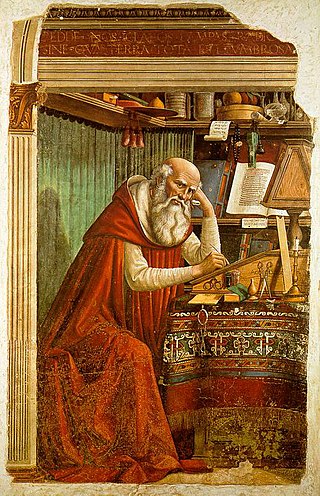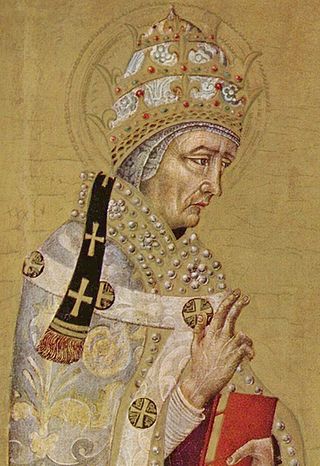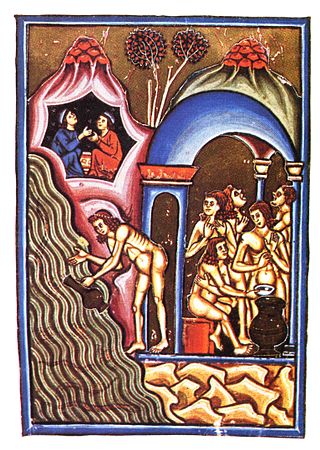Related Research Articles

The Liber Pontificalis is a book of biographies of popes from Saint Peter until the 15th century. The original publication of the Liber Pontificalis stopped with Pope Adrian II (867–872) or Pope Stephen V (885–891), but it was later supplemented in a different style until Pope Eugene IV (1431–1447) and then Pope Pius II (1458–1464). Although quoted virtually uncritically from the 8th to 18th centuries, the Liber Pontificalis has undergone intense modern scholarly scrutiny. The work of the French priest Louis Duchesne, and of others has highlighted some of the underlying redactional motivations of different sections, though such interests are so disparate and varied as to render improbable one popularizer's claim that it is an "unofficial instrument of pontifical propaganda."
Pope Gelasius I was the bishop of Rome from 1 March 492 to his death on 19 November 496. Gelasius was a prolific author whose style placed him on the cusp between Late Antiquity and the Early Middle Ages. Some scholars have argued that his predecessor Felix III may have employed him to draft papal documents, although this is not certain.
Pope Hormisdas was the bishop of Rome from 20 July 514 to his death. His papacy was dominated by the Acacian schism, started in 484 by Acacius of Constantinople's efforts to placate the Monophysites. His efforts to resolve this schism were successful, and on 28 March 519, the reunion between Constantinople and Rome was ratified in the cathedral of Constantinople before a large crowd.

The Donation of Constantine is a forged Roman imperial decree by which the 4th-century emperor Constantine the Great supposedly transferred authority over Rome and the western part of the Roman Empire to the Pope. Composed probably in the 8th century, it was used, especially in the 13th century, in support of claims of political authority by the papacy.
The Henotikon was a christological document issued by Byzantine emperor Zeno in 482, in an unsuccessful attempt to reconcile the differences between the supporters of the Council of Chalcedon and the council's opponents. It was followed by the Acacian schism.

The Vatican Apostolic Library, more commonly known as the Vatican Library or informally as the Vat, is the library of the Holy See, located in Vatican City, and is the city-state's national library. It was formally established in 1475, although it is much older—it is one of the oldest libraries in the world and contains one of the most significant collections of historical texts. It has 75,000 codices from throughout history, as well as 1.1 million printed books, which include some 8,500 incunabula.
Ursicinus, also known as Ursinus, was elected pope in a violently contested election in 366 as a rival to Pope Damasus I. He ruled in Rome for several months in 366–367, was afterwards declared antipope, and died after 381.
Decretals are letters of a pope that formulate decisions in ecclesiastical law of the Catholic Church.
Anastasius Bibliothecarius or Anastasius the Librarian was bibliothecarius and chief archivist of the Church of Rome and also briefly a claimant to the papacy.
Liber diurnus Romanorum pontificum is the name given to a miscellaneous collection of ecclesiastical formulae used in the Papal chancery until about the 11th century. It fell into disuse through the changed circumstances of the times and was soon forgotten and lost.
Bullarium is a term commonly applied to a collection of papal bulls and other analogous documents, whether the scope of the collection be general in character, or limited to the bulls connected to any particular order, or institution, or locality.

The Acacian schism, between the Eastern and Western Christian Churches, lasted 35 years, from 484 to 519. It resulted from a drift in the leaders of Eastern Christianity toward Miaphysitism and Emperor Zeno's unsuccessful attempt to reconcile the parties with the Henotikon.
Formularies are medieval collections of models for the execution of documents (acta), public or private; a space being left for the insertion of names, dates, and circumstances peculiar to each case. Their modern equivalent are forms.
Collections of ancient canons contain collected bodies of canon law that originated in various documents, such as papal and synodal decisions, and that can be designated by the generic term of canons.
Papal regesta are the copies, generally entered in special registry volumes, of the papal letters and official documents that are kept in the papal archives. The name is also used to indicate subsequent publications containing such documents, in chronological order, with summaries of their essential contents, for which English diplomatics usually use the term "calendar".

The selection of the Pope, the Bishop of Rome and supreme pontiff of the Catholic Church, prior to the promulgation of In nomine Domini in 1059 varied throughout history. Popes were often appointed by their predecessors or by political rulers. While some kind of election often characterized the procedure, an election that included meaningful participation of the laity was rare, especially as the popes' claims to temporal power solidified into the Papal States. The practice of papal appointment during this period would later result in the jus exclusivae, i.e., a right to veto the selection that Catholic monarchs exercised into the twentieth century.
The apocrisiarius or apocrisiary was the legate from the pope to the patriarch of Constantinople, circa 452–743, equivalent to the modern nunciature.

The Collectio canonum Quesnelliana is a vast collection of canonical and doctrinal documents prepared (probably) in Rome sometime between 494 and (probably) 610. It was first identified by Pierre Pithou and first edited by Pasquier Quesnel in 1675, whence it takes its modern name. The standard edition used today is that prepared by Girolamo and Pietro Ballerini in 1757.

The Collectiones canonum Dionysianae, also known as Collectio Dionysiana or Dionysiana Collectio, are the several collections of ancient canons prepared by a Scythian monk, Dionysius 'the humble' (exiguus). They include the Collectio conciliorum Dionysiana I, the Collectio conciliorum Dionysiana II, and the Collectio decretalium Dionysiana. They are of the utmost importance for the development of the canon law tradition in the West.

Germanus was the bishop of Capua from 519 or shortly before until his death. He played a major role in bringing to an end the Acacian schism, the first major schism that divided the Christian church between east and west.